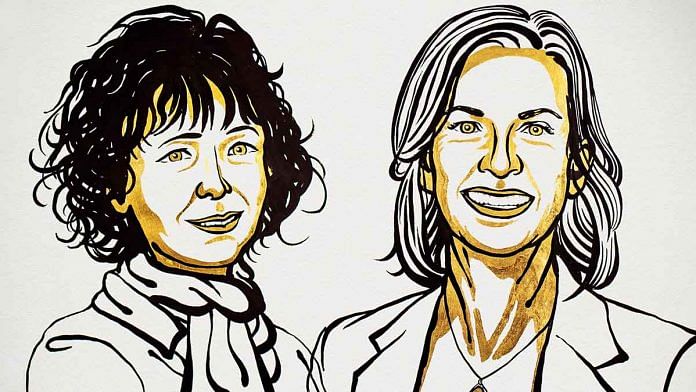Bengaluru: The 2020 Nobel Prize in Chemistry Wednesday was jointly awarded to French microbiologist, geneticist, and biochemist Emmanuelle Charpentier and American biochemist Jennifer A. Doudna for their work on the development of CRISPR-Cas9, a cutting edge, novel method for genome editing.
This is the first time a Nobel has been awarded jointly to two women, after decades of criticism by the scientific community for overlooking female scientists for Nobel prizes.
Charpentier and Doudna’s work was described by the secretary-general of the Royal Swedish Academy of Sciences, which hands out the Nobel prizes for physics, chemistry and economic sciences, as “rewriting the code of life”.
CRISPR-Cas9 gene editing has contributed to important and major developments worldwide, across multiple disciplines and applications.
The tool has made radical leaps in the field of biomedical research. It has been used to modify the genomes of three cancer patients to reprogram the immune system to fight off cancer cells in February this year, with no side effects so far. It has also been used to eliminate HIV from infected cells and is being used to reverse congenital blindness, combat diseases such as Huntington’s as well as chronic pain.
CRISPR has been used successfully in plants as well, to develop crops that are resistant to pests and drought.
ThePrint looks at why the CRISPR-Cas9 gene editing tool won the Nobel Prize for Chemistry this year, and the laureates’ contribution to its development.
Also read: 27 genes in your body now have a new name because Microsoft Excel confused them for dates
How CRISPR-Cas9 gene editing works
CRISPR stands for clustered regularly interspaced short palindromic repeats and is a family of DNA sequences which is found in genomes of bacteria and other single-celled organisms called archaea. It was first discovered and named by Spanish microbiologist Francis Mojica in 2001.
The sequences also contain the genome of a bacteriophage — virus that can infect a bacteria — that has previously infected the bacteria or archaea.
These DNA sequences can then be used to detect and destroy DNA from similar bacteriophages in the future, and play a key role in antiviral immune systems in bacteria, which is called the CRISPR-Cas system.
Cas9, which stands for CRISPR associated protein 9, is a protein that cuts DNA, providing the ability to modify the genome.
The CRISPR-Cas9 system, often described as ‘genetic scissors’, can recognise DNA from viruses naturally and prevent future infections. Charpentier and Doudna were able to determine that this mechanism could be controlled and any DNA molecule can be cut at a predetermined site.
Once a DNA is cut, it can be rewritten by inserting a different sequence and its code modified. This process can be used to alter the DNA of almost any organism.
Development and laureates’ contributions
Charpentier worked on the bacteria Streptococcus pyogenes, which causes approximately 700 million skin infections in humans each year. While working on this pathogen in the late 2000s, she noticed that the bacteria contained a previously undiscovered molecule called tracrRNA. She was able to show that tracrRNA is a part of the bacteria’s ancient immune system, the CRISPR-Cas system. Her findings were published in 2011.
Doudna, an expert on ribonucleic acid (RNA) and x-ray crystallography of ribozymes, an RNA enzyme that catalyses a chemical reaction, started to work on CRISPR independently in 2009.
In 2011, she met Charpentier at a conference in Puerto Rico, following which they began to work on CRISPR-Cas together. They recreated the bacteria’s genetic scissors in a test tube and were eventually able to reprogram the entire CRISPR-Cas9 system so that it could be controlled and be used to cut any DNA molecule at a specific site on the genetic sequence, thus fundamentally altering the genetic code of the organism.
For the process, Chinese-American biochemist Feng Zhang played a major role in optimising CRISPR-Cas9 for use in mammalian cells. Charpentier and Doudna published their groundbreaking work in 2012.
Independent Lithuanian biochemist Virginijus Šikšnys was actually the first to successfully prove that the gene editing technique works, mere months prior to the paper’s publication.
However, his paper was rejected and subsequently published in another journal three months after Doudna and Charpentier’s paper.
A hotly-contested battle and patent dispute has ensued about the credit for CRISPR-Cas9 development since then, with the four aforementioned scientists.
Since 2012, CRISPR-Cas9 gene editing has been adopted widely and rapidly due to its simplicity and cost-effectiveness. Inexpensive ‘do-it-yourself’ CRISPR toolkits are even available online.
Also read: Study identifies gene variations that increase susceptibility to Covid-19
Nobel selection criticisms
The Royal Swedish Academy of Sciences has been criticised for their lack of female winners across disciplines, but especially in the sciences, for several decades now.
The Chemistry Nobel has been awarded to a total of 178 male scientists and only seven female scientists, so far.
Many noteworthy female scientists have been snubbed in the past for the Chemistry Nobel.
Chemist Isabella Karle made valuable contributions to developing methods to determine the crystal structure, for which her male collaborators, husband Jerome Karle and Herbert A. Hauptman shared the 1985 Chemistry Nobel.
Crystallographer Kathleen Lonsdale provided the first experimental proof of the benzene ring, which many scientists state should have been recognised by the committee. Lise Meitner, who discovered nuclear fission with Otto Hahn was nominated 48 times, but the Nobel was awarded to Hahn solely in 1944.
Agnes Pockels developed a mechanism to measure soap-film surface tension in 1882, upon which Irving Langmuir’s own apparatus was built. Langmuir won the Chemistry Nobel for it in 1932.
In recent years, the scientific community had been urging the committee to award the Nobel to scientists for their work on CRISPR, which was considered a favourite to win this year.
Also read: Stanford University develops gene-editing tool that can destroy Covid-19 inside human cells



